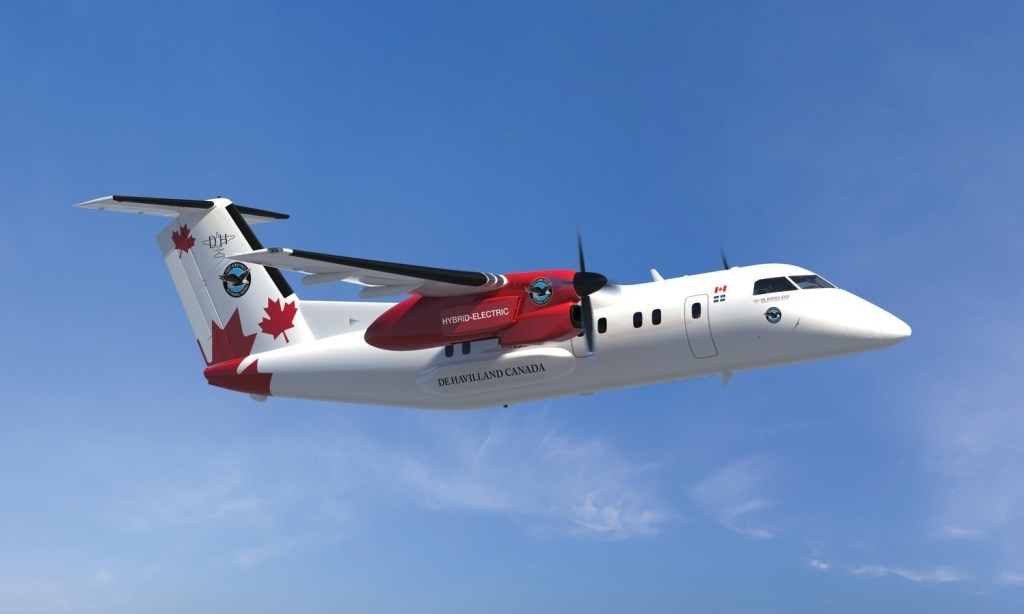EF Global VTOL
17 Mar 2023

Pratt & Whitney Canada and De Havilland Canada are collaborating in the development of a hybrid-electric propulsion system for regional aircraft that will represent the next step-change in efficiency for aircraft engines.
At a press conference organized by the Governments of Canada and Quebec on July 15, the Prime Minister of Canada, the Rt. Hon. Justin Trudeau, and the Premier of Quebec, François Legault, plus other government ministers announced financial assistance of up to CAN$685 million to three leading companies in the Canadian aerospace sector: Pratt & Whitney Canada, Bell Textron Canada, and CAE.
The announcement included up to $49 million from the Government of Canada and $20.5 million in loans from the Government of Quebec to Pratt & Whitney Canada to support a $163 million project to develop all the technological components to design the first hybrid-electric propulsion demonstrator aircraft. A grant of $8.3 million was already awarded to support part of the development work under another funding program.
In April 2019, Pratt & Whitney Canada teamed up with Collins Aerospace (both units of UTC and now Raytheon Technologies) to launch what was then known as “Project 804,” which referred to the distance in miles between the Canadian and US based teams.
A former US Airways Express Dash 8-100 from Avmax and flown to P&WC flight test facility in Mirabel, Quebec where one of the aircraft’s 1.4 megawatt (1,900 hp) PW120 turboprops would be replaced by a parallel hybrid system consisting a one megawatt (1,340 hp) gas turbine optimized for cruise efficiency and augmented by similar sized battery-powered electric motor to provide extra power for takeoff and climb.
Collins is responsible for developing the electric propulsion and motor controller at its facilities in Rockford, Illinois, but work slowed in the summer of 2020 as a result of the coronavirus pandemic.
The objective is to develop a parallel hybrid-electric engine system that can achieve at least a 30% reduction in fuel burn and CO emissions and a 20 percent reduction in airline operating and maintenance costs, compared to a modern regional turboprop airliner.
P&WC hasn’t revealed any details regarding the gas turbine engine it will use in the new hybrid-electric system, but the power required is available within the PT6A-67 turboprop engine family which powers aircraft such as the Pilatus PC-12 and Leonardo AW609 tilt rotor. The PW100 produced primarily for regional aircraft spans the 1,800 to 5,000 hp range.
Both Canada and Quebec are seeking to revive the economy by supporting new technologies that will increase employment and aerospace exports as well as support a green recovery plan.
The Government of Canada's Strategic Innovation Fund is backing the technology demonstrator, which will help put Canada's aerospace industry at the forefront of global efforts tomake aviation more sustainable.
The Government of Quebec is supporting this project through Investissement Québec and the Ministère de l'Économie et de l'Innovation, as part of an initiative known as, "Aéronef pour la mobilité numérique et verte de demain" (Green and Digital Aircraft of Tomorrow).
De Havilland Canada will support the integration of the new hybrid-electric propulsion technology and batteries within the Dash 8-100 airframe, including designing a modified nacelle structure to house the hybrid-electric technology, and will also be responsible for the cockpit interfaces needed to safely monitor and control the hybrid-electric technology. De Havilland Canada will conduct the flight test and demonstration program and interface directly with Transport Canada for the corresponding experimental flight permit.
P&WC will target ground testing in 2022, leading to flight testing of the Dash 8-100 demonstrator in 2024.
Approximately 1,300 Dash 8s have been produced including 672 “classic” models (Dash 8-100/200/300) and 630 Dash 8-400s. P&WC sees the market for the hybrid system includes new clean sheet aircraft as well as older models. In February, DHC announced it was pausing Dash 8-400 production this summer because of a lack of orders.
More than a decade ago, the development of the Pratt & Whitney PW1000 Geared Turbo Fan (GTF) achieved a significant reduction in operating costs, resulting in its widespread market adaption.
“Pratt & Whitney Canada is proud to be part of Canada’s green recovery plan and to be collaborating with De Havilland Canada in the development of the hybrid-electric propulsion technology by utilizing a Dash 8-100 regional aircraft as our flying demonstrator,” said Maria Della Posta, President, Pratt & Whitney Canada. “Hybrid-electric technology holds considerable potential to drive the next step-change in efficiency for aircraft engines, while contributing to the development of the industry’s workforce, economic growth and innovation.”
“Canada has an opportunity to demonstrate environmental leadership in the aviation sector,” said Dave Riggs, Chief Transformation Officer, De Havilland Canada. “De Havilland Canada has a legacy of innovation that has supported aviation in Canada and around the world for more than 90 years and we are immensely proud to be the first manufacturer of regional aircraft supporting the development of hybrid-electric propulsion technology.
Countries like Norway, which is home to a large fleet of Dash 8, plans to transition all short haul air services in the county to electric aircraft by 2040.
In April 2020, Airbus and Rolls-Royce made the joint decision to end development of the E-Fan X, which would have seen, one of the four jet on a BAe RJ100 test aircraft be replaced by a 2MW electric motor.